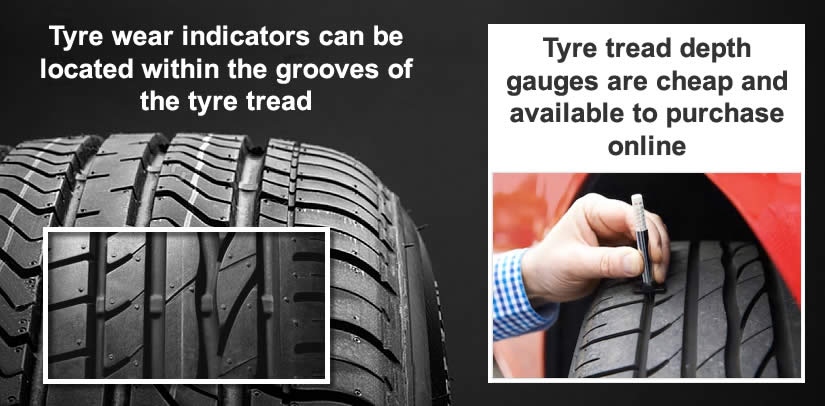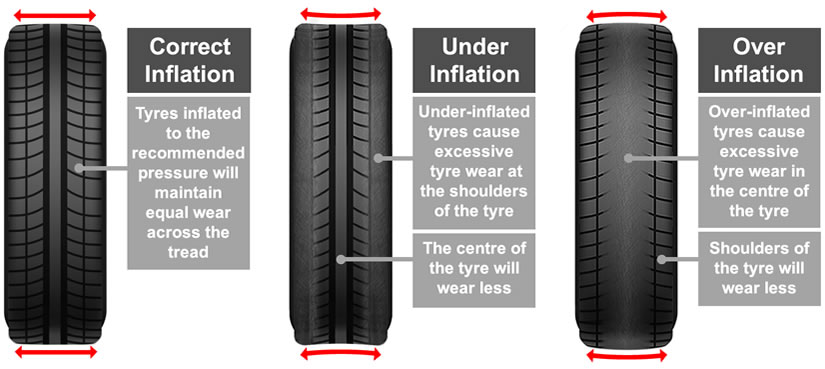Car Tyre Care Tips
Part of car maintenance is looking after and checking your tyres. Tyres are after all what connects you to the road, so frequent checks and maintenance is important not only for safety, but also so that your vehicle remains roadworthy and legal. With that in mind, let’s run through some car tyre care tips.
Checking Tyre Pressure
The first car tyre care tip is for maintaining the correct air pressure. Tyres constantly lose pressure due to a combination of temperature fluctuation and permeation (where the air inside the tyre slowly passes through the rubber). Pressure loss varies from 1-3 psi (pound per square inch) per month depending on temperature variation and the type of tyres you have fitted to your vehicle.
To avoid excess pressure loss, tyres should be checked when they’re cold and around once every two weeks and especially before a long drive. The correct tyre pressures can be found on the tyre pressure plate located inside the driver’s door. On some vehicles, you may find a sticker inside the fuel filler cap. Manufacturers recommended tyre pressure may also be found in the car owners manual.
Under-Inflated Tyres
Under-inflated tyres can result in:
- Excess wear around the shoulders of the tyre
- Increase in fuel consumption
- Vehicle instability
- Reduced handling capability
- Increased tyre heat
- Increased risk of tyre blowout
- Increased risk of tyre damage
Over-Inflated Tyres
Over-inflated tyres can result in:
- Excess wear around the centre of the tyre
- Vehicle instability
- Reduced handling capability due to less road traction
- Increased risk of tyre blowout
- Increased risk of tyre damage
Tyre Tread Depth
The second but equally important car tyre care tip is for checking your tyre tread depth. Tyre tread is essential for dispersing water when driving in the wet. Low tyre tread not only reduces your vehicle’s handling and stopping ability in wet conditions, it can also get you in trouble with the law.

How to Check Tyre Tread Depth
You can check your tyre tread depth by locating tyre wear indicators that can be found inside the grooves of the tread. The wear indicators are raised a little higher than the minimum legal limit of 1.6 mm, so when your tread pattern gets close to the markers, it’s time to get them changed.
Tyre tread depth gauges are also available online. Gauges range from cheap plastic sliders to digital versions and they’re all very easy to use.
Legal Tyre Tread Depth
For all four road tyres to be legal, there must be a minimum of 1.6 mm of tread remaining on at least three quarters of the central breadth of the tyre and around the entire circumference.
Low Tyre Tread Depth
Low tyre tread depth can result in:
- An increased stopping distance in the wet
- Vehicle instability on corners in the wet
- Drivers with tyres under the legal tread depth limit can face fines of £2,500 and 3 penalty points per illegal tyre
Correct Tyre Pressure, Uneven Tyre Wear
Even if you maintain correct tyre pressures, you may still experience uneven tyre wear and this could be due to an incorrect wheel balance or alignment.
What is Wheel Alignment?
Both front wheels should be aligned parallel with each other. The wheel alignment is off when one or both wheels angle changes so that the wheels are no longer parallel. Wheels that are out of alignment will cause uneven tyre wear and this can occur due to hitting or mounting kerbs and driving through potholes. If you have the knowledge and tools at hand, you can fix your car’s wheel alignment yourself. Failing that, most vehicle repair workshops offer this service.
What is Wheel Balance?
Your car’s tyres should have an exact weight around the entire circumference. If a tyre’s weight becomes uneven, it’ll cause steering wheel vibration when driving at speed and may also cause uneven tyre wear. Having your wheels balanced is a simple procedure that requires having each wheel tested on a machine. Small lead weights are then affixed to your wheels to correct the balance.
How You Drive Can Affect Tyre Wear
When driving, we should all aim to accelerate moderately and gradually and slow down in good time to avoid heavy use of the brakes. The harder we accelerate and brake, the more fuel is used and the greater the wear-and-tear to our vehicle. This includes tyre wear.

This is a great piece of reading material. The article I read informed me about care tyres tips.